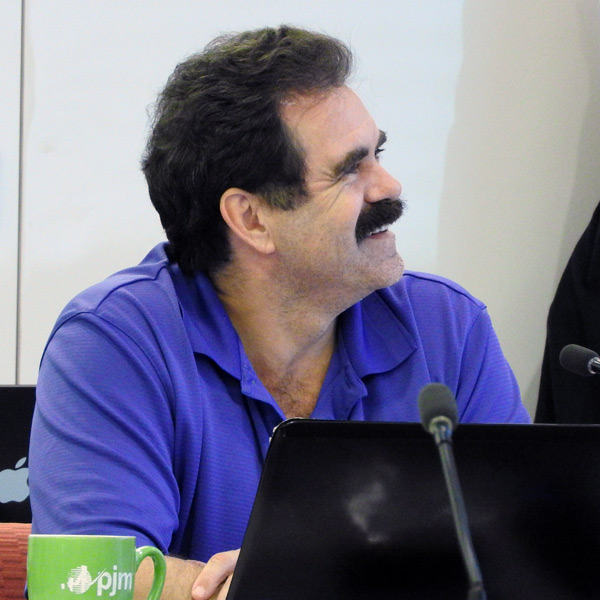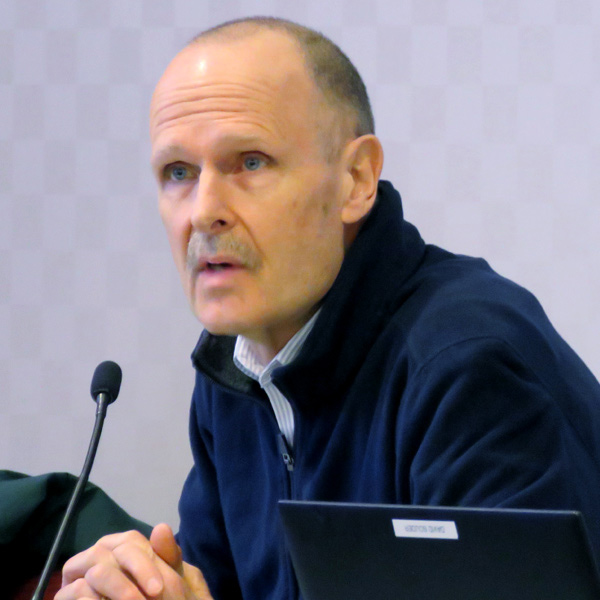
Vote on Minimum Run Time Guidance Delayed
PJM delayed a vote at last week’s Market Implementation Committee meeting on a proposal addressing pseudo-modeled combined cycle minimum run time guidance after stakeholders asked for more time to review the changes.
Tom Hauske, principal engineer in PJM’s performance compliance department, reviewed the proposal that included adding language to Manual 11: Energy and Ancillary Services Market Operations. The issue charge for the proposal was endorsed at the January MIC meeting, and stakeholders immediately began working on a solution. (See “Minimum Run Time Guidance Endorsed,” PJM MIC Briefs: Jan. 12, 2022.)
Market sellers can model a combined cycle unit as multiple pseudo units composed of a single combustion turbine and a portion of a steam turbine. Hauske said the potential exists for one or more of the pseudo-modeled units to operate for a period beyond the minimum run time parameter limit for an identical non-pseudo-modeled combined cycle unit if the market units of a pseudo-modeled combined cycle unit are dispatched at different times on parameter-limited schedules (PLS).
The proposed solution calls for adding language to Manual 11 to require market sellers to update the minimum run time of any second and subsequent pseudo-modeled block to remove the associated steam turbine start-up time that is included in the parameter limit when it’s dispatched.
Hauske said PJM removed language calling for “hourly” updates of the minimum run time parameter in order to avoid creating a “compliance trap” for market sellers who have several pseudo-modeled combined cycle units.
Adrien Ford of Old Dominion Electric Cooperative said she would appreciate the opportunity to circulate the updated manual language with ODEC staff before a vote to see what potential impact removing the “hourly” language could have on operations.
“ODEC’s wholly supportive of not creating compliance traps,” Ford said.
Calpine’s David “Scarp” Scarpignato said he agreed with taking more time to circulate the manual language internally.
“It’s very different than last month’s language, so I would recommend a delay,” Scarp said.
Hauske said PJM wants to have final endorsements by the March 23 Markets and Reliability Committee meeting because the RTO’s unit-specific parameter adjustment process starts Feb. 28. PJM must provide a determination on the requests by April 15.
PJM staff agreed to delay the vote on the proposal but will proceed with conducting a first read of the language at the Feb. 24 MRC meeting.
Manual 27 Revisions Endorsed
Stakeholders unanimously endorsed manual revisions related to a recent FERC order in response to industrial customers’ protest of PJM’s proposed revisions to its administrative rates.
While FERC accepted it for filing, the commission in December ordered hearing and settlement judge procedures for PJM’s proposed tariff revisions changing its administrative cost recovery to monthly rates based on that month’s costs and that month’s billing determinations. (See FERC Sets Hearing on Industrials’ Challenge to PJM Administrative Rates.) The PJM Industrial Customer Coalition had protested the proposal.
Rebecca Stadelmeyer of PJM’s market settlement development department reviewed the revisions to Manual 27: Open Access Transmission Tariff Accounting, which include reorganized wording to distinguish between administrative rates and pass-through rates, and a new section to only be reconciliation for transmission owner scheduling system control and dispatch service.
The manual changes will now go to the Feb. 24 MRC meeting for final endorsement.
Manual 18 Revisions
Jeff Bastian, senior consultant in PJM’s market operations department, provided a first read of revisions to Manual 18: PJM Capacity Market to conform with several recent FERC orders regarding:
-
-
- PJM’s revisions to the application of the minimum offer price rule (MOPR), which became effective by operation of law in September when the commission deadlocked (ER21-2582);
- PJM’s October compliance filing to amend several sections of Attachment DD of the tariff establishing a replacement market seller offer cap (EL19-47);
- restored tariff provisions related to the prior backward-looking energy and ancillary services (E&AS) offset for the 2023/24 Base Residual Auction and beyond (EL19-58); and
- the removal of the 10% cost adder for the reference resource used to establish the variable resource requirement curve (ER19-105).
-
Bastian said language in section 3.3.2 was updated to reflect that the net E&AS of the reference resource combustion turbine will be calculated using the forward-looking methodology with application of the 10% adder for only the 2022/23 delivery year. The net E&AS will be determined using the historical approach and without application of the 10% adder for all other delivery years.
The revisions also delete language in section 5.4.5.2 describing the consequences of accepting a state subsidy after electing the competitive exemption or certifying that a resource is not state-subsidized.
Stakeholders will vote on the changes at the March MIC meeting, with a final vote planned for the March 23 MRC meeting.
Critical Gas Infrastructure
Jack O’Neill of PJM’s demand response department provided a first read of a problem statement and issue charge addressing the recommendation for demand response participation in a FERC and NERC report on last February’s winter storm in Texas and other parts of the South.
The report included a key recommendation “to require balancing authorities’ operating plans (for contingency reserves and to mitigate capacity and energy emergencies) to prohibit use of critical natural gas infrastructure loads for demand response.”
PJM began discussions with curtailment service providers (CSPs) through the Demand Response Subcommittee to identify impacted loads for the 2021/22 winter season, O’Neill said, and it developed a preliminary definition of critical gas infrastructure loads.
O’Neill said CSPs have cooperated with PJM to identify impacted loads in the RTO’s DR Hub application so dispatchers have “operational awareness.” PJM estimates there are about 20 facilities of critical gas infrastructure load that participate as DR in the RTO’s wholesale markets, amounting to around 95 MW of winter capability and 190 MW of summer capability.
The key work activities of the issue charge include defining critical gas infrastructure loads and PJM market participation rules in compliance with FERC/NERC recommendations and developing a transition mechanism if new participation rules impact member’s capacity commitment.
PJM wants to assign the work to the Demand Response Subcommittee. Work on the issue is expected to last 12 months, and the goal is to file any necessary tariff changes with FERC in the first quarter of 2023.
“It’s not a huge issue for PJM considering our demand response fleet is roughly 6,500 MW,” O’Neill said. “But it’s still something that needs to be addressed.”
Stakeholders will vote on the issue charge at the March MIC meeting.
Operating Reserve Clarification
Phil D’Antonio of PJM’s energy market operations department provided a first read of a problem statement and issue charge addressing clarifications and potential enhancements to the rules for paying operating reserve credits to resources operating when requested by the RTO.
D’Antonio said PJM pays energy uplift to market participants under specified conditions to ensure that competitive market outcomes “do not require efficient resources to operate for the PJM system at a loss.” He said the uplift payments are intended to act as one of the incentives for generation owners to offer energy for dispatch based on short-run marginal costs and to operate units as directed by the RTO’s operators.
PJM wants to clarify the definition of “operating as requested by PJM” in both the tariff and manuals because it “lacks the type of systematic approach” found in the definition of “following dispatch,” D’Antonio said, which is used in assessing balancing operating reserve deviation charges. He said PJM and the Independent Market Monitor have had debates over the meaning of the definition.
“We feel the current definition isn’t as specific as we would want it to be and leads to different interpretations as we apply operating reserve credits and uplift payments,” D’Antonio said.
The key work activities in the issue charge include determining a definition of “operating as requested by PJM” as it relates to payment of operating reserve credits. It also seeks to establish alternative rules addressing the megawatt level to which balancing operating reserve credits should be paid to resources found not to be closely following PJM’s commitment and dispatch instructions.
The issue will be worked on at the MIC, D’Antonio said, with the potential for special MIC meetings to be scheduled as needed. Work is expected to last around nine months.
Calpine’s Scarp said he would like to see discussions include how renewable resources will get credits and an “explicit piece of the issue charge” on what renewable resource output is compared to determining credits or deviations.
 PJM Monitor Joe Bowring | © RTO Insider LLC
PJM Monitor Joe Bowring | © RTO Insider LLCMonitor Joe Bowring said he has been bringing up this issue for at least four years and was glad to see PJM and stakeholders deciding to tackle it. He also appreciated the opportunity to work with PJM in developing the issue charge and problem statement.
Bowring added, however, that they did not agree about the current rules or the appropriate solution. Bowring said the Monitor will continue to pursue parallel paths to address the issues associated with paying uplift to units not following dispatch, including making referrals to FERC’s Office of Enforcement.
“It’s essential to get these issues clarified,” Bowring said.

